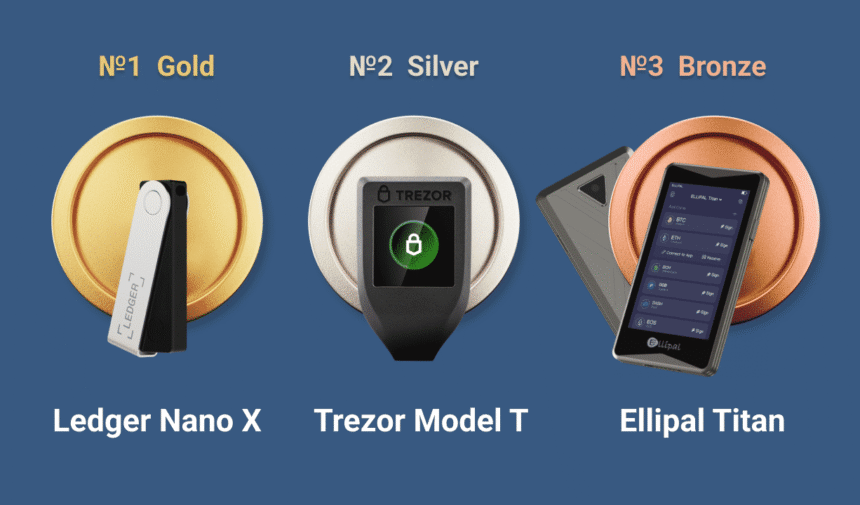Introduction
The digital revolution has ushered in a new era of finance one characterized by decentralized ledgers, peer‐to‐peer transactions, and the promise of financial sovereignty. Yet with great innovation comes great risk. Stories of exchange hacks, phishing scams, and software vulnerabilities have highlighted the fragility of online custody solutions. For anyone serious about protecting significant cryptocurrency holdings, cold wallets also known as hardware wallets represent the gold standard in security.
By isolating private keys within tamper‐resistant hardware, cold wallets eliminate the primary threat vectors that plague hot wallets and custodial services. This comprehensive exploration embarks on a meticulous examination of the leading cold wallets available today, evaluating their security architectures, usability features, asset support, and overall value proposition. Whether you hold Bitcoin, Ethereum, altcoins, or a diversified portfolio of tokens, this guide will enable you to select a fortress capable of defending your digital wealth against evolving threats.
The Case for Cold Storage
In contrast to hot wallets which operate on internet‐connected devices such as smartphones, desktops, or web browsers cold wallets generate and store private keys in a fully offline environment. This architectural divergence renders cold wallets immune to remote exploits, malware injection, and phishing campaigns that target software wallets.
The moment you transfer assets into a hardware wallet, you effectively remove the keys from the global network, rendering them unreachable by hackers. Moreover, most hardware wallets employ secure elements specialized microcontrollers designed to resist tampering and side‐channel attacks ensuring that even if a malicious actor obtains physical access, extracting the key material remains infeasible.
Beyond raw security, hardware wallets provide an additional layer of transaction confirmation. Every outgoing transfer must be physically authorized on the device itself, typically via button presses or touch gestures. This manual verification prevents unauthorized transactions, even if the companion software is compromised. Furthermore, the use of mnemonic seed phrases compliant with BIP39 allows for universal recoverability across devices implementing the same standard. As long as you protect your seed phrase, you can restore your assets on any compatible wallet in the event of device loss or failure.
Core Security Principles
When evaluating cold wallets, several foundational security principles should guide your decision. First, inspect the wallet’s chip architecture. A genuine secure element is critical; avoid devices relying solely on general-purpose microcontrollers. Second, favor open-source firmware whenever possible, as it permits independent audits and community scrutiny.
Third, confirm the device’s recovery mechanism: a 24-word mnemonic offers greater entropy than a 12-word phrase, while advanced schemes like Shamir Backup provide added resilience through split-seed methodologies. Fourth, ensure that the wallet enforces multi-factor transaction approval, minimizing risk in the event of lost credentials. Combined with tamper-evident packaging, sealed enclosures, and robust supply-chain verification, these elements establish a hardened platform for custodial sovereignty.
Ledger Nano X: Balancing Mobility and Security
Ledger’s Nano X represents the company’s flagship hardware wallet, blending portability with advanced security. Housed in a stainless‐steel shell, the Nano X features Bluetooth Low Energy connectivity, enabling wireless pairing with the Ledger Live mobile application. Underneath the elegant exterior lies a dual-chip configuration: one chip dedicated to secure element operations and another for general processing tasks. Private keys never exit the secure element, and all communications are encrypted end-to-end, mitigating theoretical Bluetooth attack vectors.
Setup involves generating a 24-word recovery phrase and configuring a PIN code. Ledger Live allows users to install apps for over 1,800 supported cryptocurrencies, manage portfolios, and execute firmware updates. Each transaction initiated on a connected device must be confirmed directly on the Nano X, ensuring that malicious software cannot authorize transfers unilaterally. While the convenience of Bluetooth enhances usability for travelers and mobile traders, the premium price tag places the Nano X at the higher end of the hardware wallet spectrum. Nevertheless, for users seeking a seamless blend of mobility, extensive coin support, and top-tier security, the Ledger Nano X stands as a compelling choice.
Ledger Nano S Plus: Entry-Level Excellence
For those entering the hardware wallet space on a budget, the Ledger Nano S Plus maintains the core security features of its more expensive sibling while offering an accessible price point. The Nano S Plus incorporates a secure element, PIN protection, and a 24-word seed phrase backup. Its USB-C interface provides compatibility with desktops and select smartphones via on-the-go adapters, though it lacks wireless connectivity.
Despite its compact design, the Nano S Plus supports installation of applications for over 1,500 cryptocurrencies. Users manage their holdings through the Ledger Live desktop client, which also handles firmware updates to address emerging vulnerabilities and coin integrations. Physical confirmation for transactions is required via dual button presses, nullifying remote exploits.
The primary limitation lies in its restricted onboard memory, necessitating periodic uninstallation and reinstallation of coin apps for extensive portfolios. Nonetheless, its affordability and robust security profile make the Nano S Plus an ideal gateway for beginners seeking hardware-based protection without hefty investment.
Trezor Model T: Transparency and User Experience
Trezor pioneered the hardware wallet category, and its Model T exemplifies the brand’s commitment to open-source integrity and user-centric design. Sporting a color touchscreen interface, the Model T eliminates dependency on external software for transaction verification. The underlying architecture separates the bootloader, firmware, and application layers, ensuring that each update undergoes cryptographic authentication before execution.
During initialization, users create either a 12-word or 24-word mnemonic seed phrase compliant with BIP39 standards. The touchscreen facilitates intuitive entry of the recovery phrase, reducing the risk of errors associated with button-based input. Trezor Suite, the companion application, offers portfolio tracking, staking functionality for supported coins, and seamless firmware upgrades. With support for over 1,600 tokens, including native integrations for major blockchains and Ethereum-based assets, the Model T caters to diverse portfolios.
An exclusive feature, Shamir Backup, enables splitting the seed phrase into multiple “shares,” requiring a subset to reconstruct the full seed. This mechanism provides enhanced resilience against physical loss or theft of the recovery materials. While the Model T carries a higher price than comparable devices, its open-source firmware, transparent development process, and superior user experience justify the investment for security-conscious, tech-savvy investors.
Trezor One: Proven Reliability
The original Trezor One continues to serve as a stalwart in the cold wallet arena, valued for its proven reliability and straightforward functionality. Utilizing an open-source firmware model akin to the Model T, the Trezor One focuses on minimizing complexity to reduce potential attack surfaces. A monochrome screen displays transaction details, while dual buttons facilitate PIN entry and on-device confirmations.
Users generate a 12-word recovery seed during setup and manage assets via Trezor Suite or third-party integrations such as Electrum and MetaMask. Though it lacks the touchscreen and advanced backup options of the Model T, the One’s affordability and minimalist design cater to those prioritizing core security over feature breadth.
Regular firmware updates and community-driven audits ensure continued resilience against emerging threats. As an entry-level yet dependable device, the Trezor One remains a heavyweight choice for safeguarding cryptocurrency holdings.
BitBox02: Swiss Privacy and Craftsmanship
Shift Crypto’s BitBox02 emerges from Switzerland’s renowned engineering ecosystem, emphasizing privacy, simplicity, and robust security. The aluminum-encased device integrates a secure element for private key storage and employs a microSD card slot for encrypted backups eschewing dependence on external clouds or servers. The companion BitBoxApp, fully open-source, delivers portfolio management and firmware updates with transparent codebases.
Upon setup, users choose between Bitcoin-only or multi-asset editions, each generating a 24-word seed phrase. The multi-asset edition supports major cryptocurrencies, ERC-20 tokens, and a growing list of altcoins. The device’s touch sliders replace traditional buttons, offering resistance to wear and ensuring reliable operation over extended use. Firmware releases undergo third-party security audits, reinforcing trust in the vendor’s commitment to safeguarding user assets.
While the BitBox02’s proprietary backup system demands a modest learning curve, its privacy posture and Swiss build quality distinguish it from competitors. For investors valuing data sovereignty and engineering rigor, the BitBox02 represents a compelling intersection of design, transparency, and security.
Coldcard Mk4: Bitcoin-Only Mastery
Coldcard Mk4 targets Bitcoin maximalists who demand uncompromising, air-gapped security. Developed by Coinkite, the Coldcard series isolates private keys on a dedicated secure element, offering transaction signing via microSD card transfers. This methodology enables fully offline operation, as unsigned PSBT files are imported and exported without any direct connection to a host device.
Setup begins on the device itself, generating a random 24-word seed phrase or importing an existing mnemonic. Transactions are signed via an OLED screen and physical keypad, with encrypted PIN entry thwarting side-channel attacks. Coldcard’s open-source firmware supports advanced features such as CoinJoin for enhanced privacy and native multisignature configurations for shared custody arrangements.
By narrowing its focus exclusively to Bitcoin, Coldcard eliminates the complexity associated with supporting multiple chains. This specialization facilitates deep auditing and optimization, securing it as the gold standard among Bitcoin purists. Although the user interface appears austere and the learning curve steep, veterans requiring maximal isolation and verifiability regard the Coldcard Mk4 as an indispensable tool in their security arsenal.
SafePal S1: Wireless and Accessible
SafePal, backed by Binance Labs, introduced the SafePal S1 as an affordable yet secure hardware wallet that leverages QR‐based air-gapped transaction flows. The device establishes a pairing process with the SafePal mobile application via QR codes, entirely eliminating USB and Bluetooth connections. When initiating a transaction, the app generates a QR code that the S1 scans; after signing, the device displays a new QR, which the app rescans to broadcast the transaction.
The S1’s plastic shell, built-in battery, and joystick navigation provide a comfortable user experience, while support for over 30 blockchains and thousands of tokens ensures broad compatibility. Users generate a 12-word seed phrase and can add an optional passphrase for extra protection. Although lacking a formal secure element, the S1 employs multiple encryption layers and randomized data pathways to mitigate tampering risks.
SafePal’s closed-source components and app-centric ecosystem introduce trust considerations, yet the device’s affordability and air-gapped design offer a compelling alternative for cost-conscious users seeking enhanced security over purely software solutions. For mobile-first investors prioritizing ease of use, the SafePal S1 delivers a versatile entry point into hardware custody.
Keystone Pro: Enterprise-Grade Air-Gapping
Keystone Pro elevates air-gapped security by eliminating all physical data ports and relying solely on QR code transfers. A high-resolution E-Ink display presents both unsigned and signed transaction data, while a capacitive touchscreen enables seamless navigation. Keystone’s open-source firmware undergoes frequent third-party audits, underpinning the platform’s institutional credibility.
Supporting over 100 blockchains, Keystone Pro integrates advanced features such as multi-device transaction approvals and enhanced multisignature workflows, positioning it as a suitable solution for enterprises and high-net-worth individuals. The ticket-style form factor and durable construction reflect a design optimized for longevity and operational rigor. Although the price point exceeds consumer-grade wallets, Keystone Pro’s unwavering focus on air-gap principles and auditability justifies its status as a top-tier custodian for sizable portfolios.
Emerging Innovations in Cold Storage
The hardware wallet landscape continues to evolve alongside blockchain technology. Multi-party computation (MPC) solutions are gaining momentum, distributing private key operations across multiple devices or servers to eliminate single points of failure. Biometric authentication such as built-in fingerprint sensors promises hands-free security without compromising key isolation.
Meanwhile, hybrid models that combine secure elements with encrypted cloud backups aim to streamline user experience while preserving robust protection. As DeFi, NFTs, and emerging Layer-2 ecosystems expand, hardware wallet vendors are racing to integrate native support for staking, governance, and smart-contract interactions directly on-device. These advancements herald a future where cold wallets become ever more seamless, interoperable, and resilient in the face of sophisticated threats.
Selecting the Right Fortress
Choosing a hardware wallet requires aligning your threat model, technical comfort, and asset composition with the device’s capabilities. Investors holding predominantly Bitcoin may prioritize air-gapped, Bitcoin-only platforms like Coldcard Mk4. Diversified portfolios demand broad token support and intuitive interfaces, favoring devices such as Ledger Nano X or Trezor Model T. Cost-sensitive entrants can find peace of mind in budget options like Ledger Nano S Plus or SafePal S1.
Institutional users and high-net-worth individuals should evaluate enterprise-grade solutions like Keystone Pro for advanced multisignature and audit functionalities. Regardless of choice, secure handling of mnemonic backups, disciplined firmware updates, and purchase from authorized channels remain non-negotiable practices for preserving custody integrity.
Cryptocurrencies
As cryptocurrencies mature into mainstream assets, the imperative to safeguard digital wealth intensifies. Cold wallets stand at the forefront of self-custody solutions, marrying cutting-edge security architectures with growing usability. From the mobile-friendly convenience of Ledger Nano X to the air-gapped perfection of Keystone Pro, the market offers a spectrum of fortresses tailored to diverse needs and threat models.
By understanding each device’s security underpinnings, feature sets, and usability trade-offs, you empower yourself to select a wallet that not only withstands present-day threats but adapts to tomorrow’s challenges. In the realm of decentralized finance, true ownership begins with control of private keys, and nothing secures them like a well‐chosen cold wallet.




